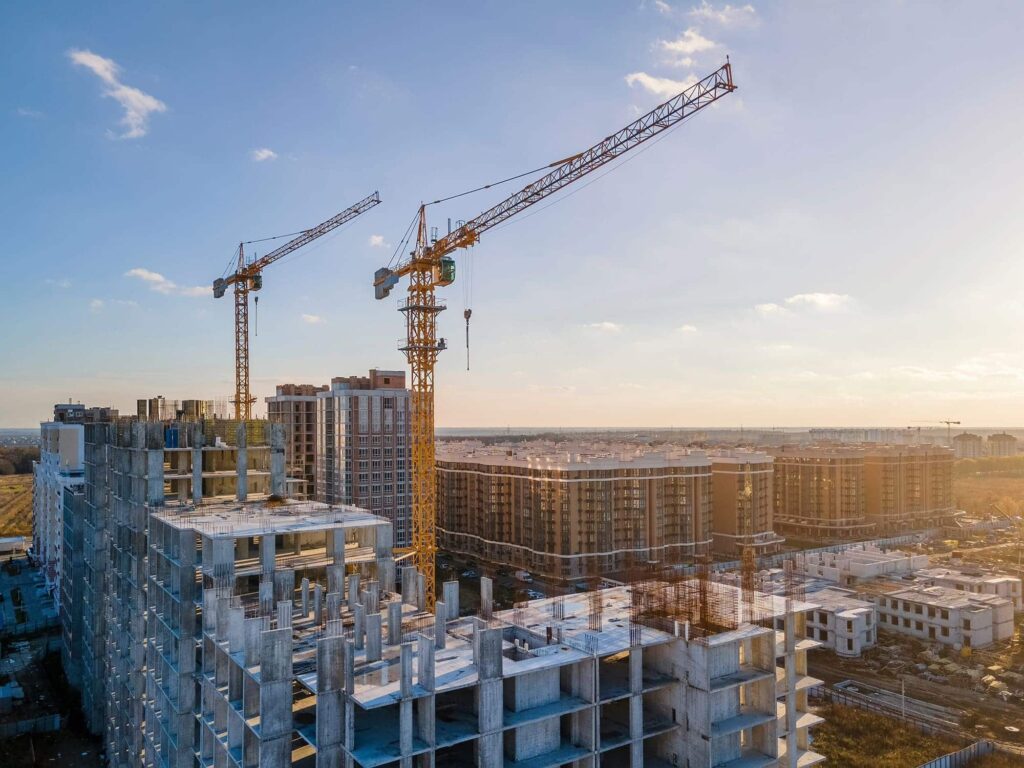
The transformation of the construction sector is a fact. Gone is the image of a traditional construction site, full of unforeseen events, manual processes and eternal deadlines. Today, on-site industrialization is positioned as an innovative and efficient alternative that not only optimizes resources and time, but also responds to the new environmental and social demands of the market.
Contenido
What is industrialization in construction?
Industrialization in construction consists of transferring a large part of the construction processes from the construction site to a controlled environment, such as a factory or workshop. There, complete elements or components of a building are produced – such as bathroom modules, facades, structures or installations – which are then transported to and incorporated into the final project site.
This approach breaks with the logic of traditional construction, where each process is executed on site, often conditioned by climatic factors, labor availability or coordination problems.
On-site industrialization models
Industrialization can be applied at different levels depending on the type of project:
- Industrialization by components: manufacturing of specific parts such as walls, stairs, electrical or sanitary installations.
- Modular systems: manufacture of complete modules (rooms, kitchens, bathrooms) that are assembled like a Meccano at the final location.
- Complete 3D VolumetryIn some cases, almost complete dwellings are built in the factory and only require final connection on site.
Why is interest in this methodology growing?
The rise of industrialization is due to several key factors:
- The need to reduce lead times in a market that demands speed and efficiency. in a market that demands speed and efficiency.
- Lack of skilled labor in many countries in many countries.
- Pressure to build more sustainably and with less environmental impact. and with less environmental impact.
- Digitization of the sectorThe digitalization of the sector, which makes it possible to design, plan and execute with greater precision thanks to tools such as BIM (Building Information Modeling).
Current situation: how is industrialization evolving?
In countries such as Swedenindustrialization already accounts for more than 90% of residential construction. The Netherlands, Germany and the United Kingdom have also opted for this model, with figures that are growing steadily.
At Spainprogress is slower, but steady. Currently, it is estimated that only 1% of single-family homes are built with industrialized processes. However, according to the Building Cluster, it is expected that by 2030 this number will grow to represent between 30% and 40% of new housing of new housing, reaching 7,500 units per year 7,500 units per year compared to 850 in 2022.
Advantages of industrialized construction
1. Quick turnaround time
Projects are executed in less time thanks to standardized and parallel processes (while manufacturing is taking place, the site is being prepared). This reduces lead times and improves planning.
Increased sustainability
By working in the factory, the use of materials is optimized and on-site waste is minimized. In addition, the displacement of machinery and people is reduced.
3. Quality and precision
Controlled environments allow for greater quality control at every stage, reducing errors and improving finishes.
4. Increased security
By minimizing work at heights or in adverse weather conditions, occupational hazards are significantly reduced.
5. Reduction of indirect costs
Although the initial investment may be similar or slightly higher, the reduction of time, errors and maintenance in the long term represents considerable savings.
Industrialization challenges
Despite its many advantages, industrialization still faces some challenges:
- Cultural change in the sectorwhich still maintains traditional inertias.
- Lack of specific regulationwhich does not always contemplate these construction methods.
- Need for coordination between designers, manufacturers and constructors, especially in the planning phase.especially in the planning phase.
Where are we headed?
Industrialization is not a passing fad: it is a necessity for a sector that must adapt to resource scarcity, sustainability requirements and the demand for faster, more affordable and efficient housing.
In addition, its integration with technologies such as BIM, artificial intelligence, 3D printing o robotization opens the door to a new era of fully digitized, flexible and customized construction.
Conclusion
On-site industrialization is the present and the future of construction. Companies that adapt to this new methodology will not only improve their competitiveness, but will also be prepared to lead a market that is changing at breakneck speed.
The challenge is no longer to ask if it is viable, but when and how to start applying it in our projects. but when and how to start applying it in our projects..
Is your company ready to lead the transformation towards industrialization in the on-site industrialization? At 3D Global Consultingwe are your perfect partners to integrate these advanced methodologies, optimizing your projects in terms of deadlines, costs and sustainability.
Contact us today and find out how we can help you.
| Dimension | Primary Focus | Key benefit |
|---|---|---|
| 3D | Geometric design | Visual coordination |
| 4D | Time | Schedule optimization |
| 5D | Costs | Dynamic financial control |
| 6D | Sustainability | Reduction of environmental impact |
| 7D | Asset management | Efficient maintenance |
